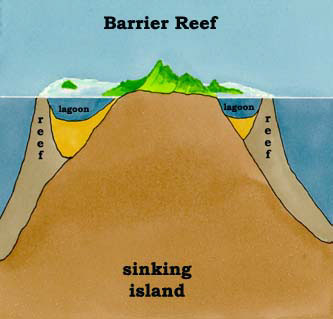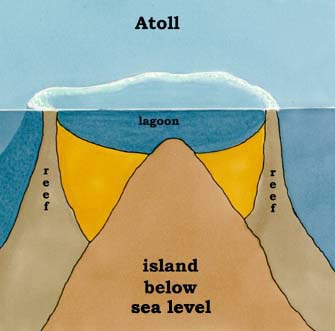| A stable year-round climate is common in the tropical marine environment. This means there are few environmental changes throughout the year and no real seasonal changes in sunlight, ocean water temperature, or surface nutrients. There is almost always plenty of sun, warm sea surface temperatures, and few surface nutrients in the ocean water. |
The author (Genny) and her family, diving in the tropics. (GA image) |
| A thermocline is generally present in the tropical marine environment. The abundant year-round sunlight and heat warms surface ocean water in the tropics enough so that it has a lower density than the subsurface water. This surface (warmer) water stays separated from the subsurface (cooler) water by a layer of water where the temperature rapidly changes with depth (the thermocline). This warm water is very comfortable for divers. |
| A thermocline locks out nutrients from surface ocean water. In aquatic environments most living organisms sink when they die. The dead bodies decompose on the bottom of the aquatic environment. This decomposition is what releases nutrients (in the form of nitrogen - N, phosphorous - P, and potassium - K) back into the environment. It is these nutrients (N, P, and K) that are required for plant growth. We often call them 'fertilizers.' The thermocline separates the bottom (cool, nutrient-rich) water from the surface (warm, nutrient-poor) water in the ocean. Thus, the tropical ocean water is warm but nutrient poor at the surface. |
| Plants need nutrients and sunlight for proper growth. In the marine environment the base of the food chain is primarily microscopic marine plants floating in the surface waters. These plants are called phytoplankton and photosynthesize to grow. They need sunlight for photosynthesis so can only be found in surface ocean waters. But, they also need nutrients. When present in the tropics the phytoplankton rapidly use up any nutrients in the surface water. These nutrients are not replaced as long as there is a stable thermocline. |
Clear blue water in the tropics is common as viewed from on top of the water and from under the water. (GA images) |
| Clear, blue tropical water signifies little plankton. The phytoplankton in the tropics is nutrient limited pretty much year-round. There is another type of plankton, the zooplankton (animal plankton) that feeds on the phytoplankton. They are the second step in the marine food chain. In turn, they are eaten by larger critters, like small fish, and so on up the food chain. So, with a lack of the base of the marine food chain (phytoplankton) there are few zooplankters and few small fish. This condition, in the tropical ocean, results in a lack of life and low productivity in most areas. (There are exceptions where nutrient-rich bottom water surfaces due to upwelling.) |
Coral reefs have a great diversity of life. (GA image) |
| Coral reefs are an exception to the lack of life in the marine tropical waters. These reefs are built from a unique type of coral called a hermatypic coral and can only exist in warm ocean water. Hermatypic corals really are a symbiotic combination of a coral animal and an organism called a zooxanthellae. It is the unique relationship (described in the next section on 'The Coral Animal') between these two species that allows coral reefs to grow and exist year after year, providing a place for many other species and the rich habitat of the coral reef. |
Aerial view of the stages of coral reefs (fringing, barrier, atoll). (LJF images) |
| Classic coral reef formations change through time. They begin with a brand new tropical island (produced by an oceanic hot spot or at a plate boundary) and gradually change through thousands of years from a fringing reef, to a barrier reef, to an atoll, and finally to an extinct reef as a seamount or guyot. |
| A new oceanic island in the tropics will have no terrestrial or marine life when it is first formed. This new island will be made entirely of crustal material (rock) with little or no evidence of life forms. If there is no more volcanic activity and the island cools there will be a succession of life forms that may arrive by flying, floating or swimming. These forms may stay and establish themselves if conditions there are good for them. Over time a thriving community will be found on land as well as in the ocean. |
Fringing reef showing island and reef growing right next to the island. (LJF image) |
| A fringing reef forms along the shoreline of most new tropical islands. This is because the reef building coral animal is one of the few marine organisms that can survive in the warm, nutrient-poor surface tropical waters. In fact, the reef building coral (hermatypic) can only survive in warm, clear ocean waters (such as would be common around a new oceanic island). The coral animal reproduces sexually with a microscopic planktonic larval form that is abundant in tropical waters during coral reproduction. Most of these larvae never grow to adults because there is no place for them to exist in the warm surface ocean waters on a solid surface. They need to attach to a solid surface that will stay in the warm, sunlit, clear tropical water and most places are already taken … but not on a new island. So a coral reef forms along the edge of this new island, right next to the island and is called a fringing reef - the first step in 'classical' coral reef formation. |
 |
Barrier reef showing sinking island, separated from reef by a lagoon. (LJF image) |
| A barrier reef forms as the oceanic island begins to sink into Earth's crust due to the absence of volcanic island building forces, the added weight of the coral reef, and erosion at the surface of the island. As the island sinks, the coral reef continues to grow upward. The coral animals lay down tremendous amounts of calcium carbonate (in part due to their symbiotic zooxanthellae) in the form of their skeletons (called corallites). If conditions are good they can usually keep pace with the sinking island. Their living tissue remains in the upper part of the reef in the warm, clear, tropical water. The lower part of the reef is composed of the calcium carbonate skeletons left by the reef building coral. This upward growth creates a lagoon of water between the top of the reef (that started as a fringing reef) and the sinking crustal island. The lagoon fills in with eroded material from both the reef and the island and is a haven for marine forms that require protection from waves and storms. This barrier reef is generally not a complete circle as it may be broken, here and there, by storms. |
 |
Atoll showing the island below sea level and a lagoon in the center of the reef. (LJF image) |
| An atoll forms when the oceanic island sinks below the surface of the ocean but the coral reef continues to grow upward. The atoll is usually circular in shape but a broken circle (due to the history of storms). Eroded reef material may pile up on parts of the reef, creating an area above sea level, an island called a 'cay.' Cays may become stabilized enough (often through plants) to provide a permanent island for buildings. Cays may also be unstable and move across the reef or disappear. |
The three stages of coral reef formation - fringing, barrier, and atoll. (LJF images) |
| A seamount or guyot forms when the coral reef cannot keep up with the sinking of the island. Seamounts and guyots are below the surface of the ocean and may be home to a large number of species depending on their location and depth. Seamounts are rounded on the top and guyots are flat-topped. The flat top of the guyot is from its existence at the surface for some time and being planed down by waves (thus the flat top). |
A beautiful coral reef. (SA image) |
| Many variables need to be considered when learning about these classical coral reefs. Their state depends on many things, location, rate of sinking, history of storms, etc. It was Charles Darwin, in the mid 1800s, who first proposed this theory of coral reef development. He saw new volcanic islands, fringing reefs, barrier reefs, and atolls in his South Pacific travels and developed this theory. Later, oceanographers could prove his theory when they drilled cores in the center of atoll lagoons and always found evidence of an oceanic crustal island below the surface, the atolls themselves made only of reef products. |
| More coral species live in the Pacific Ocean than anywhere else in the world. The Caribbean reefs may average some 20 to 25 species of coral whereas the western Pacific reefs (near Australia) average over 300 species. The center of coral diversity is in this Australia/New Guinea area. But, all coral reefs are beautiful, no matter what their diversity. |
|

